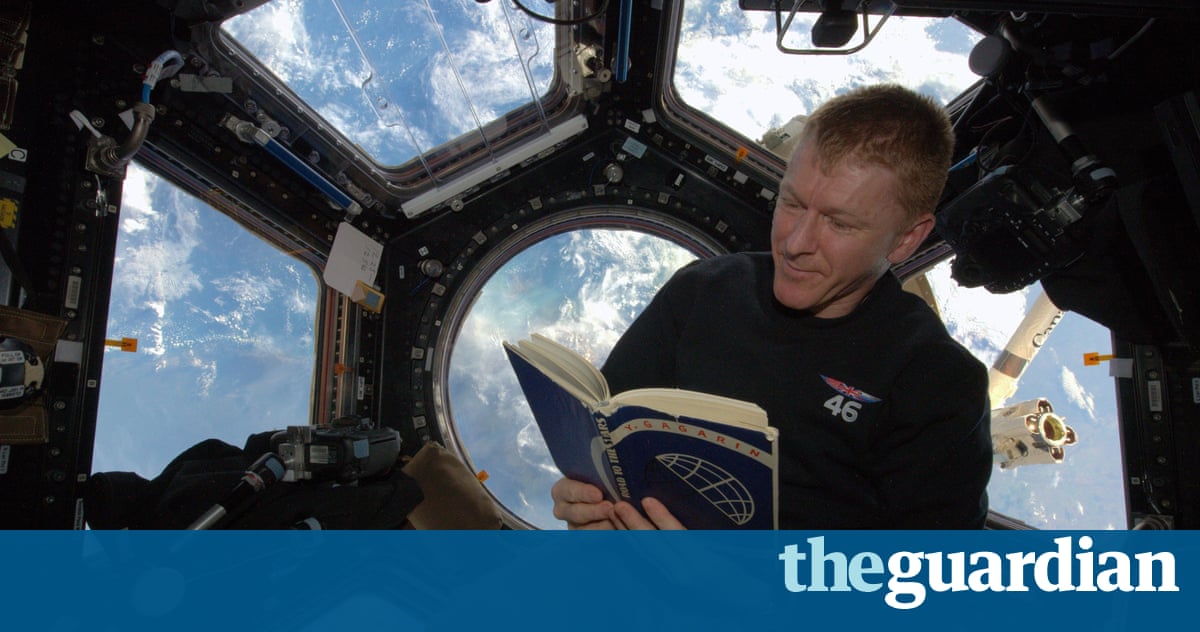Tim Peake comes back to Earth with a bump Soyuz touchdown ends astronauts incredible journey

After 186 days orbiting the Earth, Briton returns from space

Tim Peake returned to Earth yesterday at the end of his six-month stay on the International Space Station. His journey home took place in a craft that fell from a height of 410 kilometres and decelerated from 27,600 km/h to a standstill in less than four hours. The 44-year-old astronaut described the trip as the best ride Ive been on ever.
Peake was crammed into a tiny Soyuz capsule with two other astronauts the American Tim Kopra and the Russian cosmonaut Yuri Malenchenko and ended up in a remote patch of the Kazakhstan steppe.
Just after touchdown, their Soyuz capsule, which measures just over two metres in diameter, was blown on to its side by a gust of wind. However, all three crew members were reported to be in good shape.
One by one they were lifted out of the capsule which was charred by the heat of re-entry and placed in chairs. Peake was the second to leave. He looked exhausted and had his eyes closed at first. However, he later smiled and gave a thumbs up to TV crews.
Im just truly elated, he said. The smells of the Earth are so strong. Its just wonderful to feel the fresh air. Im looking forward to seeing the family now. Peake described his 186-day stay on the space station as a life-changing experience then revealed he might treat himself to a pizza and cold beer.
Im going to miss the view [from the space station] definitely, he added. And Id love some cool rain right now. It was very hot in the capsule and the suits very hot.
Britains first official astronaut was later pictured sitting outside the space capsule talking on a mobile phone to members of his family.
During his time in space he worked up to 14 hours a day and took part in more than 250 experiments devised by scientists from around the world. He said his missions highlight was the space walk he conducted with Kopra in January to repair electrical components on the outside of the space station.
Peake was originally scheduled to come back to Earth at the beginning of June, but his homecoming was delayed when the launch of the replacement crew was pushed back.
That return journey began early yesterday morning when the three men had scrambled from the space station into the Soyuz TMA-19M spacecraft that had carried them into space on 15 December last year.
Closing the hatch of the Soyuz marked the end of Peakes Principia mission which had earned him an honour Companion of the Order of St Michael and St George from the Queen for his extraordinary service beyond our planet. The Soyuz then undocked from the space station and a four-minute 37-second burn of its rockets slowed its velocity to allow it to begin its plunge into Earths atmosphere. Shortly after this de-orbit burn, explosive bolts split the Soyuz into three parts.
The central, spherical orbital module containing the crew members plunged towards the Earth, friction on its forward-facing heat shield slowing its speed from 27,600kph to 830kph (17,000mph to 500mph) while enveloping the craft in a ball of superheated plasma that raised outside temperature to 1,600C. The remaining parts of the craft, which included its service module and control systems, were allowed to burn up in the atmosphere.
During the descent, Peake, wearing a Sokul spacesuit, was strapped into the right-hand seat, with Malenchenko in the centre. As the craft plunged towards Earth, the crew were forced back into their shock-absorbing seats and experienced a force of up to five times normal Earth gravity, a level that can cause blackouts.
The experience, according to one Nasa astronaut, Doug Wheelock, is like going over Niagara Falls in a barrel, but the barrel is on fire, while the Canadian astronaut Chris Hadfield described the descent as physically extremely violent its like 15 explosions followed by a car crash.
A few minutes later, the capsule deployed its main parachutes to further slow its descent. Then, just a few seconds before landing, its six landing engines were fired to cut its impact speed to 5kph, further cushioning its landing near the Kazakhstan city of Zhezkazgan at 10.15am British time.
The spacecraft then turned over several times after its relatively hard landing because of the relatively high winds on the steppe before it toppled over on its side.
The return to Earth had been controlled automatically by the crafts on-board computer. However, in an emergency, the crew, led by Malenchenko, could have taken control of their craft. In fact, the return trip went precisely according to plan, ending with a bullseye landing on its targeted arrival zone.
After exiting the craft the crew were taken into the care of medical experts to begin the lengthy process of readjusting to gravity. Then they were flown to Karaganda, the regional capital, by helicopter for a traditional welcoming ceremony involving gifts of bread and salt and Kazakh hats.
The trio were then scheduled to go their separate ways, with Peake taking a plane to the European Astronaut Centre in Cologne. Kopra heading for Houston and Malenchenko travelling to Star City, near Moscow.
Since he was launched into space on 15 December last year, Major Tim Peake has spent 186 days in zero gravity, has orbited the Earth 2,720 times in the International Space Station and has travelled a total of 114 million kilometres around our planet at an average height of 410km. During that time, he has run a marathon on a treadmill, taken a spacewalk to replace a failed electronics unit and carried out more than 250 experiments in medical science, radiation physics and materials.
It has been a spectacular experience, the 44-year-old astronaut observed towards the end of his mission though for all that time Peake, like other astronauts, has had to learn how to cope with a host of inconveniences: minimal changes of clothing (about once a week); having to remember to clip down every object he uses, including pens or notebooks, which would otherwise float away and get lost; and living off vacuum-packed drinks and dehydrated foods.
These are transient, albeit irritating experiences. But there will be lasting effects. In particular, Peakes lengthy spell of weightlessness will have considerable effects on his health. The astronaut will suffer severe weakening of his bones as calcium will have leached from them in zero gravity. This leaves astronauts susceptible to breaking bones, like sufferers of osteoporosis and because it requires hardly any effort to move around the space station in zero-gravity, his underused muscles will have lost mass.
To try to get around these effects, Peake has been exercising on treadmills and training bikes for several hours a day. It will still take him several months to return his body to a healthy state. In addition, doctors now know that eye-pressure changes occur in astronauts who have been in space for long periods. At present, most vision problems do not seem to be permanent.
Less predictable will be the psychological effects of Peakes return to Earth, a point stressed by Helen Sherman, the only other astronaut to fly in space under the UK banner.
I found it very strange after I came back, she told the Observer in an interview given before Peake set off for the international space station. I didnt have any backup from an office. I was pretty much on my own. I was recognised constantly. I would go for a tin of beans from the supermarket and be kept chatting there for hours. It was pleasant but very exhausting.
I was also surprised about what people wanted to know when I gave talks. I had been told to keep it personal, so I talked about what face cream I used but at the end most of the audience questions were about the science.
In fact, speech itself often proves difficult for returning astronauts, a point acknowledged by the Canadian astronaut Chris Hadfield. Right after I landed, I could feel the weight of my lips and tongue and I had to change how I was talking, Hadfield told reporters after his return from the space station several years ago. I hadnt realised that I had learned to talk with a weightless tongue.
Read more: https://www.theguardian.com/science/2016/jun/18/tim-peake-health-six-months-in-space